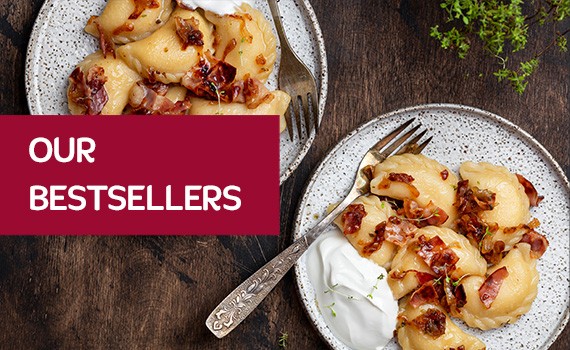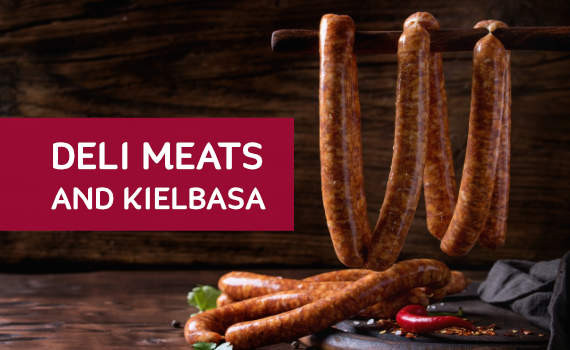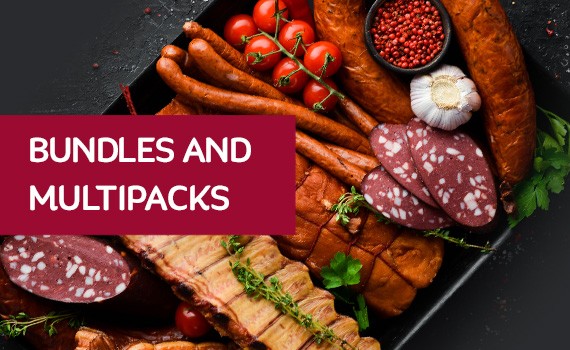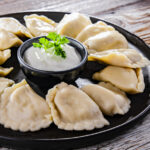Few dishes evoke the warmth and comfort of Polish cuisine quite like pierogi. These delightful dumplings, filled with savory or sweet treasures, are a staple at Polish tables and a beloved comfort food worldwide. While pierogi can be boiled or baked, frying them brings a unique textural experience – a crispy, golden exterior giving way to a soft, flavorful filling. Additionally, the convenience of using frozen pierogies allows for a quick and easy meal without compromising on taste.
Introduction to Pierogi
Pierogi are a traditional Polish dish that has gained popularity worldwide for their delicious taste and versatility. These delightful dumplings are typically filled with a variety of ingredients, such as mashed potatoes, cheese, meat, or vegetables, and are usually served with a topping or sauce. Whether you’re enjoying them as a comforting meal or a festive treat, pierogi bring a taste of Poland to your table. In this article, we will focus on how to cook frozen pierogi to achieve a perfectly fried and delicious dish.
The Magic of Fried Pierogi: More Than Just a Meal
Pierogi hold a special place in Polish hearts. They are more than just food; they’re a symbol of family, tradition, and celebration. Often, families gather to make pierogi together, turning the process into a cherished bonding experience. Each family might have its own secret recipe, passed down through generations, making their pierogi truly unique. To save time while still enjoying a traditional meal, many families cook frozen perogies, using methods like boiling or frying in butter.
Frying is one way to prepare this dish. It offers a satisfying contrast in textures. The gentle heat transforms the dough, creating a delightful crispness. This complements the soft filling inside.
Choosing Your Pierogi: A World of Flavors
The beauty of pierogi lies in their versatility. Whether you are using fresh or frozen pierogi, you have many filling options to choose from. Frozen pierogies are convenient and can save time while still delivering a homemade taste.
Some classic fillings that are perfect for frying include:
- Potato and Cheese: A timeless combination, offering creamy, cheesy goodness with the comforting earthiness of potatoes. This is the most popular in Poland.
- Sauerkraut and Mushroom: A savory and slightly tangy option, often enjoyed during the Christmas season. The earthy mushrooms balance the tartness of the sauerkraut.
- Meat: Typically made with ground pork, beef, or a combination, seasoned with herbs and spices. This provides a hearty, protein-rich filling.
- Farmer’s Cheese: This offers a slightly sweet and tangy flavor that complements the fried dough.
Important Note: When selecting pierogi for frying, opt for ones with a slightly thicker dough. This will help prevent them from breaking apart during the cooking process.
Essential Ingredients for Perfectly Fried Pierogi
To achieve the perfect fried pierogi, you will need the following essential ingredients:
- Frozen pierogi (preferably with a thick pasta shell): The thicker dough helps prevent the pierogi from breaking apart during frying.
- Olive oil or other cooking oil with a high smoking point: Olive oil is a great choice for its flavor and ability to withstand high heat.
- Salt (preferably thick salt or kosher salt): Adds essential seasoning to enhance the flavor of the pierogi.
- Optional toppings: Sour cream, caramelized onions, melted butter, or other toppings of your choice can elevate the dish to new heights.
These ingredients will ensure that your pierogi are crispy on the outside and perfectly cooked on the inside, ready to be enjoyed with your favorite toppings.
Methods for Frying Pierogi: Finding Your Perfect Crisp
There are several ways to achieve that perfect golden-brown crust on your pierogi. Each way offers a different level of involvement and control.
1. Pan-Frying: The Classic Approach
Pan-frying is the most common and arguably the easiest method for frying pierogi, making pan fried pierogies a versatile dish with a crispy exterior and creamy interior.
What you’ll need:
- A large skillet (non-stick is recommended)
- Your choice of cooking oil (see recommendations below)
- A spatula or tongs
Instructions:
- Add enough oil to your skillet to lightly coat the bottom.
- Heat the oil over medium-high heat. You’ll know it’s ready when a drop of water sizzles upon contact.
- Carefully place the pierogi in the skillet, ensuring they are in a single layer and not overcrowded. Overcrowding will lower the oil temperature and result in soggy pierogi.
- Cook for approximately 3-4 minutes per side, or until golden brown and crispy. The exact time may vary depending on the thickness of the dough and the heat of your pan.
- Remove the pierogi from the skillet and place them on a plate lined with paper towels to drain excess oil.
Adding sautéed onions, caramelized in butter, can enhance the flavor of pan fried pierogies, creating a delicious and comforting dish.
2. Deep Frying: For the Ultimate Crunch
Deep frying creates pierogi that is golden brown. This approach gives a very crunchy outcome.
What you’ll need:
- A deep fryer or a large, heavy-bottomed pot
- Enough oil to fully submerge the pierogi
- A slotted spoon or spider for removing the pierogi
- Thermometer (optional, but helpful for maintaining the correct oil temperature)
Instructions:
- Heat the oil in your deep fryer or pot to 350°F (175°C). Using a thermometer is the most accurate way to ensure the correct temperature.
- Carefully lower the pierogi into the hot oil, a few at a time, to avoid overcrowding.
- Fry for approximately 3-4 minutes, or until the pierogi are golden brown and float to the surface.
- Remove the pierogi from the oil using a slotted spoon or spider and place them on a plate lined with paper towels to drain. Serve immediately to ensure optimal taste and texture.
3. Air Frying: A Healthier Twist
Air frying has benefits. It gives you a crispy texture similar to deep frying but with much less oil. Using frozen pierogies for air frying is especially convenient, saving time while still delivering a homemade taste.
What you’ll need:
- An air fryer
Instructions:
- Preheat your air fryer to 400°F (200°C).
- Arrange the frozen pierogi in the air fryer basket in a single layer. Avoid overcrowding.
- Cook for 10-12 minutes, flipping halfway through, until golden brown and crispy. The exact cooking time may vary depending on your air fryer model.
Choosing the Right Oil: The Foundation of Flavor with Olive Oil
The type of oil you use can affect both the flavor and the healthfulness of your fried pierogi. Always choose an oil with a high smoke point. It can withstand the heat without breaking down and releasing harmful compounds.
Good options include:
- Canola Oil: A neutral-flavored oil with a high smoke point, making it a versatile choice.
- Vegetable Oil: Another neutral-flavored option that is readily available and affordable.
- Sunflower Oil: Similar to canola and vegetable oil in terms of neutrality and high smoke point.
- Clarified Butter (Ghee): Adds a rich, buttery flavor. It has a higher smoke point than regular butter.
Achieving the Perfect Finish
To achieve the perfect finish for your pan-fried pierogi, follow these tips:
- Use a generous amount of olive oil in the pan to prevent the pierogi from sticking. The oil should coat the bottom of the skillet evenly.
- Heat the oil to the right temperature (medium-high heat) to achieve a golden brown color. You’ll know the oil is ready when a drop of water sizzles upon contact.
- Cook the pierogi for the right amount of time: About 4 minutes on the first side and 2-3 minutes on the second side. This ensures a crispy exterior and a cooked interior.
- Use a slotted spoon to remove the pierogi from the pan and drain excess oil on paper towels. This helps keep them crispy and not greasy.
- Serve the pierogi immediately with your choice of toppings, such as sour cream, caramelized onions, or melted butter. Freshly fried pierogi are best enjoyed hot and crispy.
By following these tips, you’ll achieve perfectly fried pierogi that are golden brown and delicious every time.
Serving Suggestions: Elevating the Pierogi Experience with Caramelized Onions
Fried pierogi are delicious on their own, but the right toppings and accompaniments can take them to the next level.
Classic Polish Toppings:
- Sour Cream: A dollop of cool, tangy sour cream is the most traditional topping.
- Caramelized Onions: Slowly cooked onions, often with a touch of butter or oil, add sweetness.
- Fried Onions: Crispy fried onions provide a satisfying crunch and savory flavor.
- Bacon Bits: Add a smoky, salty element that complements the richness of the pierogi.
- Chopped Fresh Dill: A sprinkle of fresh dill adds a bright, herbaceous note.
Other delicious options:
- Applesauce: The sweetness will be great addition to the flavor.
- Mushroom Sauce: It is great way to have your pierogies served.
Ready to Enjoy the Taste of Poland?
Frying pierogi is a simple yet rewarding culinary adventure. It brings the authentic taste of Poland to your kitchen. Whether you prefer the classic pan-fried method, the deep-fried crunch, or the healthier air-fried option, the result is a delicious. It is comfort food that is sure to satisfy.
If you’re craving authentic Polish pierogi but don’t have the time or ingredients to make them from scratch, Polka-Deli is here for you. We offer a wide variety of delicious, handmade pierogi. We have them with traditional and modern fillings. You can now buy pierogi online. Have a taste of Poland delivered right to your doorstep.
Beyond Frying: Other Ways to Cook Frozen Pierogies
While frying offers a unique textural experience, frozen pierogies can also be prepared in other versatile ways:
- Boiling: This is the most traditional method. It results in soft, tender dumplings. Simply drop the pierogi into boiling, salted water and cook until they float to the surface.
- Baking: Baking pierogi gives them a slightly crispy exterior. It is also a good option for larger batches. Preheat your oven to 375°F (190°C). Place the pierogi on a baking sheet. Brush them with melted butter or oil, and bake for about 20-25 minutes. Do it until they are golden brown.
The History of Pierogi
Pierogi have a rich history, and are very popular in Polish culture. The exact origin is unknown. It’s origins are in Central and Eastern Europe. Some legends attribute their arrival in Poland to Saint Hyacinth. He was a 13th-century Dominican priest. He is said to have brought them from Kyiv (present-day Ukraine). Others claim they were introduced even earlier, through trade routes from the Far East.
Regardless of their precise origin, pierogi became a staple of Polish cuisine. They are enjoyed by all social classes. Originally, they were often associated with special occasions and holidays. Different fillings were traditionally used for specific celebrations. For example, sauerkraut and mushroom pierogi are commonly served during Christmas Eve dinner (Wigilia). Meat pierogi are often found at weddings.
Over time, pierogi making became a family tradition. Recipes and techniques were passed down through generations. Regional variations emerged. They reflected local ingredients and preferences. Today, pierogi remain a beloved symbol of Polish heritage. They are a culinary treasure enjoyed around the world.
Pierogi Making – Tips
Making pierogi is not very hard. But there are things to make it perfect.
- Dough. Use good flour to make a dough.
- Filling. Do not put to much filling.
- Shape. Make sure that edges are glued.
- Cooking. Cook them in batches.
Pierogi Around The World
Pierogi, while strongly associated with Polish cuisine, have close relatives in many other cultures. The concept of a filled dumpling is universal. You will find many variations around the globe.
- Ukraine: Varenyky are very similar to Polish pierogi. They are often filled with potatoes, cheese, sauerkraut, or fruit. They are typically boiled and served with sour cream or fried onions.
- Slovakia: Bryndzové halušky are small potato dumplings. They are not filled. Usually they are served with bryndza (a sheep cheese) and bacon. Pirohy, the Slovakian version of pierogi, can have various fillings. They can be sweet or savory.
- Russia: Pelmeni are smaller than pierogi. They are usually filled with meat (beef, pork, or lamb) and seasoned with onions and spices. They are boiled and served with sour cream, butter, or vinegar.
- Italy: Ravioli and tortellini are types of filled pasta. The fillings and shapes are different. The basic idea is similar to pierogi.
Conclusion
Cooking frozen pierogi can be a quick and easy way to achieve a delicious and satisfying meal. By following the tips and techniques outlined in this article, you can achieve perfectly fried pierogi with a crispy exterior and a cooked interior. Remember to use the right ingredients, cook the pierogi at the right temperature, and serve them immediately with your choice of toppings. With a little practice, you can become a pierogi-cooking pro and enjoy this traditional Polish dish in the comfort of your own home.









